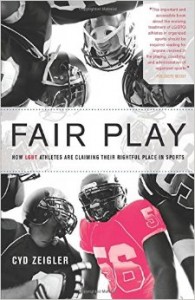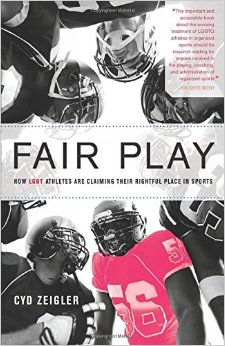 Fair Play: How LGBT Athletes Are Claiming
Fair Play: How LGBT Athletes Are Claiming
Their Rightful Place in Sports
by Cyd Zeigler
Akashic Books. 288 pages, $15.95
A DECADE AND A HALF after a spate of homophobic incidents on the courts, on the fields, and in the locker rooms of American sports, LGBT athletes are beginning to enjoy a certain amount of acceptance. So argues Cyd Zeigler, founder of Outsports magazine, who points out that fans want their teams to win and largely don’t care about its players’ choice of bed partners. Even as far back as 2005, over three-fourths of fans questioned said they were okay with gay athletes. Lack of acceptance, argues Zeigler, is more likely to come from teammates, owners, and others inside sports organizations. Using his access to athletes, managers, and coaches—something that teams often go to absurd lengths to restrict—he picks apart the homophobic inner worlds of amateur and professional sports.
At the high school level, Zeigler indicates that public schools are increasingly open to the presence of gay athletes and coaches and less tolerant of homophobic behavior—which is not to say that none exists. Zeigler spotlights one young man who had to remain closeted throughout his high school years in order to gain entrance to a Christian college, and then tearfully remained in the closet in order to keep his scholarship. The presence of Bible-based teachings at some colleges, as well as team hazing, teasing, and outright harassment at many others, are psychologically damaging to young gay athletes at all levels.
In his examination of the boys-will-be-boys culture of the locker room, Zeigler compares the teasing that straight athletes receive to the harassment that gay players endure, especially in physical horseplay and in commonplace but derogatory slurs that question a player’s masculinity. Zeigler is at pains to debunk locker room myths about gay men looking at their naked teammates in the showers, arguing that all men have a psychological need to be naked together. Here, as elsewhere, he doesn’t back up this curious claim with research or arguments that would give it credibility.
The general situation for lesbian athletes is quite different. There seems to be more acceptance, perhaps because the presence of lesbians in sports is more widely acknowledged, even taken for granted, and because out lesbian athletes have been around for longer than have openly gay male athletes. When a lesbian athlete comes out today, there is barely any notice; indeed women’s sexuality in general seems to be of little interest in sports commentary. Zeigler admits that his focus in this book is on gay men rather than on lesbian athletes, but the latter topic surely demands more attention, as does the fate of transgender athletes, who have only recently entered public awareness.
On balance, things seem to be slowly changing for the better in sports at all levels. Ziegler cites stories of NFL players who publicly made anti-gay comments and received widespread backlash for it, apologized, and vowed to mend their ways—and then did, through volunteerism, public statements, and meetings with LGBT representatives. As Zeigler points out, a football doesn’t care who throws or catches it. This fact, along with fans’ growing indifference to the sexual orientation of their heroes, seems to have grabbed many sports organizations by the balls, as it were, over the past decade or two.
________________________________________________________
Terri Schlichenmeyer is a freelance writer based in Wisconsin.






